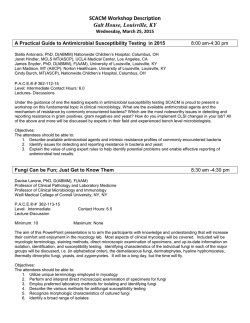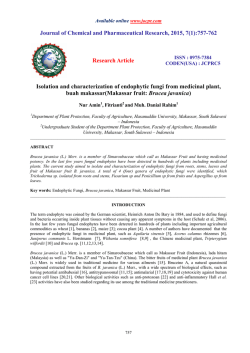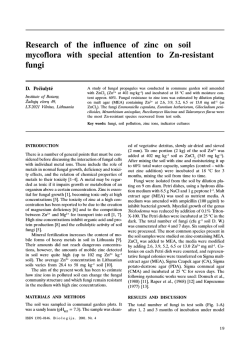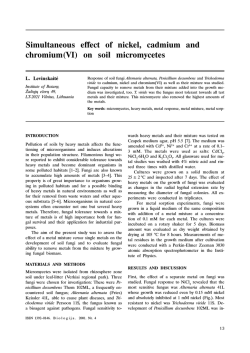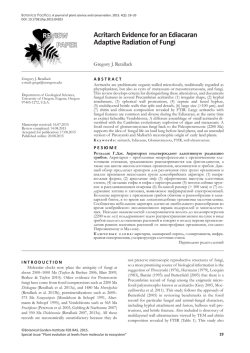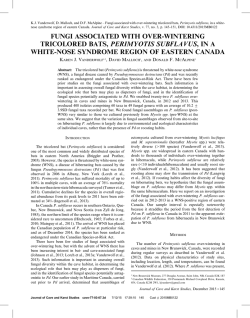
Interrelations of soil fungi in heavy metal surroundings
Interrelations of soil fungi in heavy metal surroundings Interrelations of soil fungi in heavy metal surroundings Dalia Peèiulytë Institute of Botany, Þaliøjø eþerø 49, LT-2021 Vilnius, Lithuania Fungal interaction experiments were carried out in laboratory agar-based systems. Interactions were carried out on the malt extract agar (MEA) or on the following media: MEA containing 2 or 3 mM copper (as copper sulfate), 1 or 2 mM lead (as lead nitrate), 50 or 75 mM zinc (as zinc chloride). The commonest fungi in the soil samples were tested on the metal ion-containing media. Interactions were assessed and five separate modes of interacting colony were recognized. Under laboratory conditions Trichoderma harzianum has been found to attack the test fungi in the control media and in media with copper and lead salts. The experiments showed that the chemical constituents of interaction media had a marked effect on the fungal growth rate and their antagonistic properties. Modifications of the copper, lead and zinc concentrations of the medium provided indications that the level of these three elements could prove important in the formation of fungal community in polluted soils. Key words: soil pollution, heavy metals, fungal community, fungal interactions INTRODUCTION When more than two species live in close association in an ecosystem, interaction may take place between them. If different environmental conditions specific to each of two species living in association with each other are present in a common niche, the two populations have no opportunity for interaction, be it due to low cell density or low metabolic activity, neutralism will probably prevail [18]. Fungal colonies growing in the proximity may effect significant changes in one another or may require intimate hyphal contact. Changes include trophic stimulation, morphogenic alterations and various degrees of growth inhibition. Interactions between hyphae appear to be significant in determining the pattern of colonization of dung [9, 10], competition between species of Trichoderma and other fungi [2 4, 15], Septoria nodorum and phylloplane fungi [16], and the control of Heterobasidion annosum by Peniophora [8]. A number of organisms, for example Trichoderma, Gliocladium and Scytalidium species, have been found to be antagonistic towards decay fungi in laboratory agar-based systems [15]. The primary environmental factors that influence growth and interactions between fungi, particularly between Fusarium spp. and Aspergillus or Penicillium spp., are temperature and water availability [13]. A ISSN 02357224. E k o l o g i j a range of interspecific interactions can occur between fungi, including mutual intermingling (representing overlapping domains), mutual inhibition (antagonism, or combat), and dominance by one species over another [1]. Using the index of dominance it was shown that interactions were profoundly influenced by water activity, temperature and nutrient substrate [11, 12, 15]. Recent reports [6, 17] have indicated that the chemical constituents of interaction media can have a marked effect on the nature of the interaction. Environmental factors may exert some selective pressure influencing the community structure and dominance of individual species. Soil pollutants such as heavy metals might develop the conditions that enable some of fungi in their community to became dominant. Very little information is, however, available on the type of interspecific interactions which might occur between fungi in heavymetal-polluted soils. The objectives of this study were to examine the effect of copper, lead and zinc on in vitro interspecific interactions and growth between fungi isolated from the soil. In addition, the effect of the media on the hyphal extension rates of the organisms used in the interactions was studied to determine if any simple relationships existed between the hyphal extension rate and the ability to control the plant pathogens. (Vilnius). 2002. Nr. 2 75 Dalia Peèiulytë MATERIALS AND METHODS Experiments were based on the use of eleven strains of fungi isolated from the commune garden soil. The influence of the fungi on each other in culture was examined by inoculating all possible paired combinations, 3.5 cm apart on malt extract agar (MEA) with and without metal salts addition. Strains were grown at 25 °C in the dark. Malt extract agar medium (MEA) served as minimal control (C) medium. Complete medium was the same as MEA with the addition of copper sulfate at a concentration of 2 and 3 mM Cu2+, lead nitrate at 1 and 2 mM Pb2+, and zinc chloride 40 and 75 mM Zn2+. Interactions were assessed using a key based on the observations of Porter (1924) [14], Dickinson & Boardman (1971) [5], and Skidmore & Dickinson (1976) [16]. Porter recognized five separate modes of interacting colony growth: (A) Mutually intermingling into one another without any macroscopic signs of interaction. (Bi) Intermingling growth where the fungus being observed is growing into the opposed fungus either or below or above and below its colony, and its corollary. (Bii) Intermingling growth where the fungus under observation has ceased growing and is being overgrown by another colony. (C) Slight inhibition where the fungi approached each other until almost in contact and a narrow demarcation line, ca. 11 mm, between the two colonies clearly visible. (D) Mutual inhibition at a distance of >2 mm. The interacting fungi were assigned values on a 05 scale for each type of interaction (Fig.). Between the two extremes of no inhibition and considerable mutual inhibition the assignment of intermidiate values, especially the status of intermingling growth patterns and growth around other colonies, was difficult. Growth around another fungus was placed at a lower point on the scale (3) than slight mutual inhibition (4), since in the former instance the antagonized fungus was able to withstand inhibitors produced by the antagonist. In evaluating the interactions, each fungus was assessed for its ability to inhibit the growth of another fungus, when it was termed active, and for its response to antagonism, i.e. its status as a passive species. Assessments were made when the fungi had achieved an equilibrium after which there was no further alteration in the growth pattern. In general, observations were made after 14 days at 25 °C. Hyphal extension rates of all organisms were recorded on various media by measuring colony diameters in two directions at right angles. A minimum of three measurements was taken for each sam76 Fig. Interactions observed between adjacent fungal colonies on agar media. Based on the observations of Porter (1924) and Skidmore & Dickinson (1976) ple and five replicates were used for determination of each mean. RESULTS AND DISCUSSION All of the interactions observed between Trichoderma harzianum Rifai and other fungi tested are given in Table. In general, more antagonistic interactions of T. harzianum, i.e. those rated 5, were observed in control medium and in 1 mM Cu2+ containing medium. T. harzianum is perhaps the commonest species of the genus. Worldwide occurrence on the most varied substrates is assumed [7]. In our study the percentage germination of T. harzianum was much higher under acid conditions (copper sulfate containing medium) than under neutral ones (control, lead nitrate or zinc chloride containing media). Copper sulfate addition into MEA changes medium pH from 6.5 to 4.7 (Table). When the dishes were opened, there were noticeable aromas associated with all of T. harzianum cultures growing on Cu2+-containing media. The inhibitions caused by volatile compounds were not seen on the controls. T. harzianum has a somewhat different physiology than the other test fungi. T. harzianum restarted growth after the opposed fungus accumulated or bound metal ions from the medium. Especially it was noticeable in the case when T. harzianum was pared with the fungi Aspergillus niger Tiegh. and Penicillium funiculosum Thom. T. harzianum showed its success as a colonizer of the inhibition zone around these two fungi. Interrelations of soil fungi in heavy metal surroundings Table. Interactions between oppesed colonies of Trichoderma harzianum and eleven test fungi growing on malt agar at 25°. (Scores are according to the key in Fig. Index → indicates the direction of the reactions being considered.) Control (malt extract agar) Media and its pH pH 6.5 Malt extract agar + Cu2+ Malt agar + Pb2+ (as copper sulfate) (as lead nitrate) Malt agar + Zn2+ (as zinc chloride) 2 mM 3 mM 1 mM 2 mM 40 mM 75 mM pH 4.7 pH 4.4 pH 6.4 pH 6.4 pH 6.3 pH 6.3 Tested fungi Trichoderma harzianum Rifai Alternaria alternata (Fr.) Keissl. 5↓ 5↓ 5↓ 1 3 3→ 4 Aspergillus niger Tiegh. 3↓ 4 5 1 1 5→ 5→ Botrytis cinerea Pers. et Fr. 4↓ 4 5 3↓ 4↓ 3→ 3→ Cladosporium herbarum (Pers.) Link ex Gray 3↓ 1 1 3↓ 3↓ 4 5 Fusarium oxysporum Sechlecht. 4↓ 4 45 → 3↓ 4↓ 1 3↓ Gliocladium roseum (Link) Bainier 3↓ 4 4→ 4 5 4→ 5→ Mucor racemosus Fresen. Penicillium funiculosum Thom 1 1 3↓ 3→ 4→ 1 1 3↓ 4→ 5→ 4→ 5→ 4→ 5→ Rhizopus stolonifer (Ehrenb. ex Link) Lind 1 1 3→ 3→ 4→ 3↓ 3↓ Verticillium albo-atrum Reinke & Berthold 4↓ 5↓ 5↓ 3↓ 4↓ 3→ 5→ 1 1 3 3→ 4→ 1 3→ Trichoderma viride Pers. ex Gray Previous growth of T. harzianum in control medium and medium with 2 mM Cu2+ resulted in a marked reduction in growth of A. niger, P. funiculosum, Botrytis cinerea Pers. et Fr., Fusarium oxysporum Schlecht. and Verticillium albo-atrum Reinke & Berthold (Table). This may perhaps be explained by the nutrient impoverishment of the medium by T. harzianum, or by the pH of the medium becoming unfavorable for the growth of the fungi tested. At 2 and 3 mM Cu2+ in the medium T. harzianum was inhibitory (i.e. rated 5) to fungi Alternaria alteernata (Fr.) Keissl. and V. albo-atrum, whereas T. harzianum and Cladosporium herbarum (Pers.) Link ex Gray produced intermingling growth (rated 1). At 2 mM Cu2+ intermingling growth (rated 1) occurred between T. harzianum and Rhizopus stolonifer (Ehrenb. ex Link) Lind or Trichoderma viride Pers. ex Gray. P. funiculosum behaved in a very similar manner at both copper concentrations, being most active (rated 45) against T. harzianum. T. viride and T. harzianum exibited similar activity at both copper ion concentrations. At 1 and 2 mM Pb2+ intermingling growth occurred between T. harzianum and A. niger, whereas T. harzianum (rated 3) overgrew B. cinerea, Cl. herbarum, F. oxysporum and V. albo-atrum. T. harzianum did not show uniform activity against the test fungi at 75 mM Zn2+ (Table). Only two fungi (F. oxysporum and Rh. stolonifer) were overgrown by T. harzianum at a concentration of 75 mM Zn2+. T. harzianum was antagonized by other test fungi at 2 mM Pb2+ and 75 mM Zn2+ concentrations in the medium. Fungi M. racemosus, P. funiculosum, Rh. stolonifer and V. albo-atrum were very active (rated 45) against T. harzianum in the medium with 2 mM Pb2+ and fungi A. niger, Gliocladium roseum (Link) Bainier and V. albo-atrum in the medium containing Zn2+. A number of organisms, for example, Trichoderma, Gliocladium and Penicillium species, have been found to be antagonistic towards other fungi in laboratory agar-based systems. Modifications of copper, lead and zinc concentrations of the medium provided indications that the level of these three elements could prove important in the formation of fungal community in polluted soils. References 1. Cooke R., Rayner A. D. Ecology of Saprotrophic Fungi. Logman Inc.: New York, 1984. 2. Dennis C., Webster J. Antagonistic properties of species groups of Trichoderma. 3. Hyphal interaction. Transaction of the British Mycological Society. 1971a. Vol. 57. P. 363369. 3. Dennis C., Webster J. Antagonistic properties of species groups of Trichoderma. 2. Production of volatile antibiotics. Transaction of the British Mycological Society. 1971b. Vol. 57. P. 4148. 4. Dennis C., Webster J. Antagonistic properties of species of Trichoderma. 1. Productionof non-volatile antibiotics. Transaction of the British Mycological Society. 1971c. Vol. 57. P. 2539. 5. Dickinson C. H., Boardman F. Physiological studies of some fungi isolated from peat. Trans actions of the British Mycological Society. 1971. Vol. 55. P. 293305. 6. Doi S., Yamada A. Antagonistic effects of three isolates of Trichoderma spp. against Serpula lacrymans (Fr.) 77 Dalia Peèiulytë 7. 8. 9. 10. 11. 12. 13. 14. 15. 78 gray in laboratory soil inoculation tests. The Soc. Antibact. Antifungal Agents. 1992. Vol. 20(7). P. 345249. Domsch K. H., Gams W., Traute-Heidi Anderson. Compendium of soil Fungi. Volume 3. 1980, Academic Press, London, New York. Ikediugwu F. E. O., Dennis S., Webster J. Hyphal interaction by Peniophora gigantea against Heterobasidion annosum. Transactions of the British Mycological Society. 1971. Vol. 54. P. 307309. Ikediugwu F. E. O., Webster J. Antagonism between Coprinus heptemerus and other caprophilous fungi. Transactios of the British Mycological Society. 1970a. Vol. 54. P. 181204. Ikediugwu F. E. O., Webster J. Hyphal interaction in a range of caprophilous fungi. Transactions of the British Mycological Society. 1970b. Vol. 54. P. 205210. Kessel G. J. T., de Hass B. H., Lombaers-van Plas C. H., Meijer E. M., Dewey F. M., Goudriaan J., van der Werf W., Köhl J. Quantification of mycelium of Botrytis spp. and the antagonist Ulocladium atrum in necrotic leaf tissue of Cyclamen and Lily by fluorescence microscopy and image analysis. Phytopathology. 1999. Vol. 98. P. 865877. Magan N., Lacey J. Effect of water activity, temperature and substrate on interactions between field and storage fungi. Transactions of the British Mycol. Society. 1984. Vol. 82. P. 8393. Marin S., Sanchis V., Ramos A. J. Vinas I., Magan N. Environmental factors, in vitro interactions, and niche overlap between Fusarium moniliforme, F. proliferatum and F. graminearum, Aspergillus and Penicillium species from maize grain. Mycological Res. 1998. Vol. 102(7). P. 831837. Porter C. L. Concerning the characters of certain fungi as exhibited by their growth in the presence of other fungi. American Journal of Botany. 1924. Vol. 11. P. 168188. Score A. J., Palfreyman J. W. Biological Control of the Dry Rot Fungus Serpula lacrymans by Trichoderma species: The effects of complex and synthetic media on interaction and hyphal extention rates. International Biodeterioration and Biodegradation. 1994. Vol. 33. P. 115128. 16. Skidmore A. M., Dickinson C. H. Colony interactions and hyphal interference between Septoria nodorum and phyloplane fungi. rans. Br. Mycol. Soc. 1976. Vol. 66(2). P. 5760. 17. Srinivasan U., Staines H. J., Bruce A. Influence of media on antagonistic modes of Trichoderma spp. against wood decay basidiomycetes. Material und Organismen. 1992. Vol. 27(4). P. 301321. 18. Yanagita T. Natural Microbial Communities. Ecological and physiological features. Japan Scientific Societies Press, Springer-Verlag, 1990. Dalia Peèiulytë DIRVOÞEMIO MIKROMICETØ SÀVEIKA SUNKIØJØ METALØ APLINKOJE Santrauka Mikromicetø tarpusavio sàveikos tyrimus atlikome laboratorinëmis sàlygomis ant agarizuotø terpiø. Mikromicetus auginome ant alaus misos agaro (AMA) ir ant ðios sudëties terpiø: AMA, turinèio 2 arba 3 mM Cu2+ (vario sulfato pagrindu), 1 arba 2 mM Pb2+ (ðvino nitrato pagrindu) ir 40 arba 75 mM Zn2+ (cinko chlorido pagrindu). Ant minëtø terpiø tyrëme daþniausiai ið dirvoþemio iðskirtus mikromicetus. Nustatëme penkias mikromicetø sàveikos rûðis. Laboratorinëmis sàlygomis ant kontrolinës AMA terpës ir vario priedus turinèios AMA terpës Trichoderma harzianum buvo stiprus antagonistas prieð kitus tirtus mikromicetus. Atlikti tyrimai parodë, kad augimo terpës cheminë sudëtis turi átakà mikromicetø kolonijø augimo greièiui ir jø antagonistinëms savybëms. Vario, ðvino ir cinko koncentracijø kitimas auginimo terpëje sàlygojo mikromicetø sàveikos tipà. Tai leidþia manyti, kad ðie trys metalai yra svarbûs dirvoþemio mikromicetø kompleksø susidarymui.
© Copyright 2026
